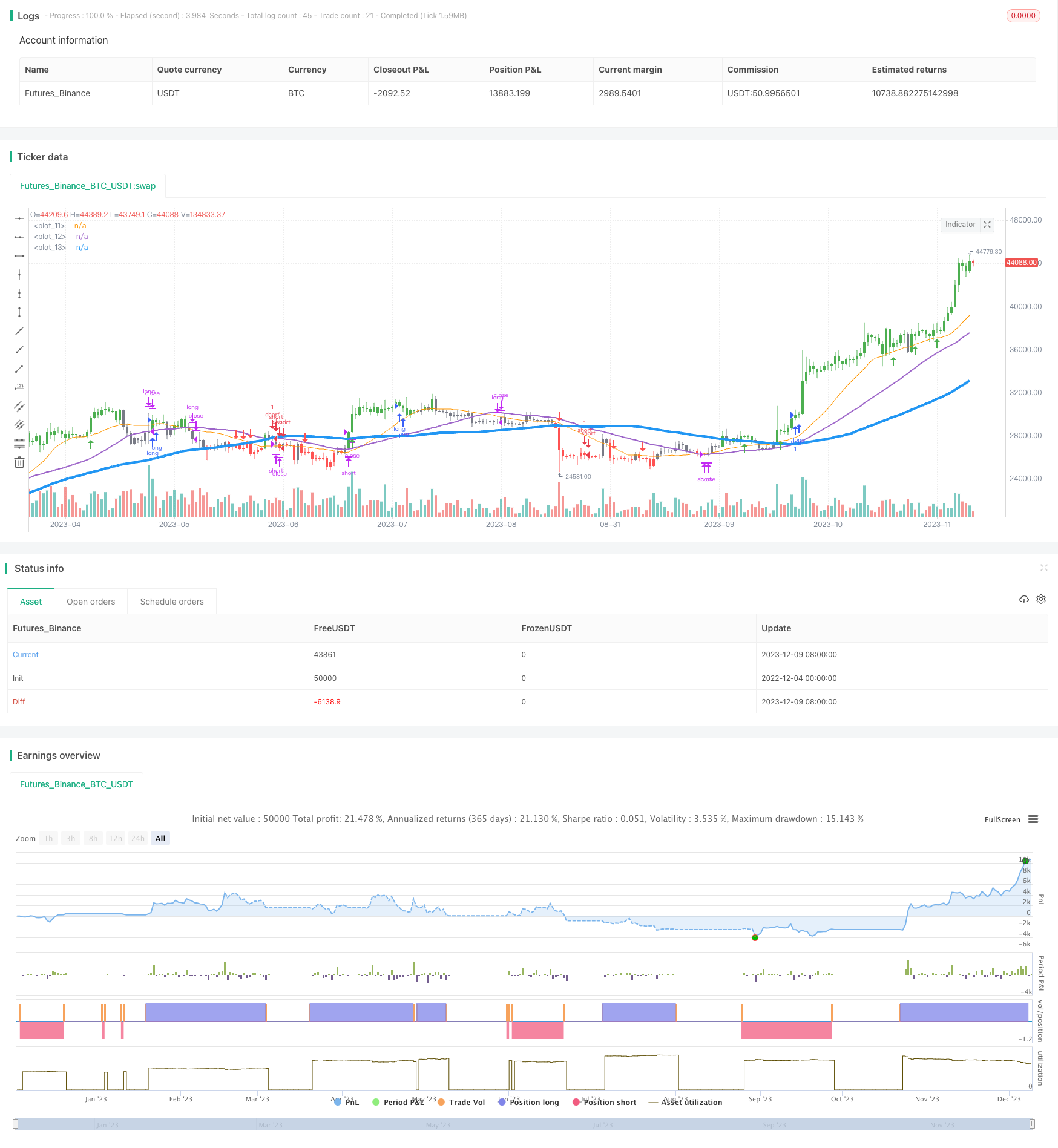
概述
本策略通过组合使用不同周期的移动平均线来确定趋势方向,并利用有限差分法近似导数来预测可能的反转点。该策略适用于小时级别的低波动性货币对。
策略原理
该策略同时使用20期、40期和80期的简单移动平均线。当收盘价高于这3条移动平均线时,定义为上升趋势;当收盘价低于这3条移动平均线时,定义为下降趋势。只有当最低价高于或最高价低于这3条移动平均线时,才确认趋势。
为了预测可能的反转点,策略利用3期中项移动平均线的有限差分法近似第一导数。当第一导数为正时,表示上升趋势稳定;当第一导数为负时,表示下降趋势稳定。
具体交易规则是:
当快速线高于中线,中线高于慢速线,并且第一导数>0时,做多;
当快速线低于中线,中线低于慢速线,并且第一导数时,做空;
多头止损当第一导数<=0时;
空头止损当第一导数>=0时。
优势分析
该策略具有以下优势:
使用多组移动平均线组合判断趋势,使趋势判断更可靠;
利用导数预测反转点,可以及时止损,回撤更小;
策略逻辑简单清晰,容易理解实现,适合新手学习;
只做趋势后的反转,避免被套,胜率较高。
风险分析
该策略也存在一些风险:
在震荡行情中,移动平均线组合可能发出错误信号;
导数反转信号可能滞后,无法完全避免损失;
止损点设定不当可能扩大损失。
针对这些风险,我们可以通过优化移动平均线的参数,调整止损位置,结合其他指标等方法来改进。
优化方向
该策略可以从以下几个方面进行优化:
优化移动平均线的周期,使其更符合不同市场的特点;
尝试不同类型的移动平均线,如指数移动平均线;
利用波动率指标设定动态止损;
结合其他指标进行確認,避免错误信号。
总结
该移动平均线组合趋势策略,利用多组移动平均线判断趋势方向,并用导数预测反转点,可以有效控制风险,适合中短线操作。策略简单易用,容易优化,是非常适合新手学习实践的趋势跟踪策略。通过进一步优化,可以使策略参数更加适应不同品种,从而获得更好的效果。
/*backtest
start: 2022-12-04 00:00:00
end: 2023-12-10 00:00:00
period: 1d
basePeriod: 1h
exchanges: [{"eid":"Futures_Binance","currency":"BTC_USDT"}]
*/
//@version=3
strategy("Big 3",overlay=true, default_qty_type=strategy.percent_of_equity)
// enter on Arrows
// take profit on touch with 80 SMA, gray, or at discretion
fast = sma(close,20)
mid = sma(close,40)
slow = sma(close,80)
plot(fast,linewidth=1)
plot(mid,linewidth=2)
plot(slow,linewidth=4)
isUptrend = close > fast and close > mid and close > slow
isDowntrend = close < fast and close < mid and close < slow
confirmed = (low > fast and low > mid and low > slow) or (high < fast and high < mid and high < slow)
deriv = 3 * mid[0] - 4 * mid[1] + mid[2]
stableUptrend = (fast > mid) and (mid > slow) and (deriv > 0)
stableDowntrend = (fast < mid) and (mid < slow) and (deriv < 0)
barcolor(isUptrend ? green : isDowntrend ? red : gray)
plotshape(not confirmed[1] and confirmed and isUptrend ? close : na,style=shape.arrowup,location=location.belowbar,color=green)
plotshape(not confirmed[1] and confirmed and isDowntrend ? close : na,style=shape.arrowdown,location=location.abovebar,color=red)
stop = na
//stop = input(1000, "Stop")
strategy.entry("long", strategy.long, when=(stableUptrend), stop=stop)
strategy.close("long", when=(deriv <= 0))
strategy.entry("short", strategy.short, when=(stableDowntrend), stop=stop)
strategy.close("short", when=(deriv >= 0))